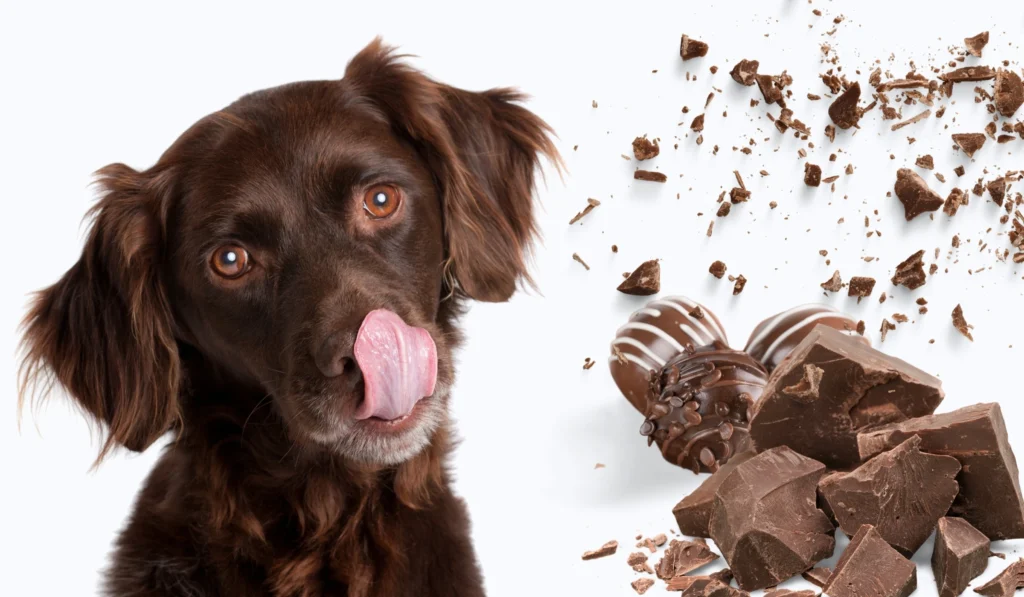Why Is Chocolate Bad for Dogs? The Bitter Truth Behind a Sweet Treat

If you’ve ever caught your dog eyeing your chocolate bar like it’s a prized bone, you’re not alone. That moment—equal parts adorable and terrifying—can send shivers down any dog parent’s spine. You might laugh at first, until the haunting thought creeps in: “Wait… is chocolate bad for dogs?”
And if you’re here because you’ve uttered those heart-stopping words, “My dog ate chocolate!”—breathe. You’re in the right place.
In this deep dive, we’ll explore why chocolate is so dangerous for dogs, what really happens when they eat it, and yes, we’ll face the question no one wants to think about: Can dogs die from eating chocolate? With vet-backed facts, real-life stories, and actionable steps, this guide is your safety net in a chocolate emergency—or better yet, your prevention manual.
Table of Contents
So, Why Is Chocolate Bad for Dogs?
Let’s get scientific for a moment—but in a way that won’t bore you to the bone.
The primary villain here is a compound called theobromine, a naturally occurring stimulant found in cocoa. While we humans handle theobromine just fine (thankfully—hello, chocolate cake), dogs metabolize it painfully slow, causing it to build up to toxic levels in their bodies. Think of it like a ticking time bomb wrapped in a sweet little truffle.
Even a small amount of chocolate can spell big trouble—especially for smaller breeds. That means even those “harmless” chocolate chip cookies or that Halloween candy your dog sneakily devoured can become a life-threatening issue.
1. Theobromine Toxicity: The Silent Killer
Imagine your dog’s body trying to digest theobromine… and failing. It lingers. It spreads. And it begins to shut things down.
Symptoms of theobromine toxicity include:
- Vomiting and diarrhea (your dog’s body trying to purge the poison)
- Panting, restlessness, or hyperactivity
- Tremors, seizures, and even coma
- An alarmingly rapid heartbeat
The darker the chocolate, the more theobromine it packs. While white chocolate contains almost none, dark chocolate and baking cocoa are absolutely loaded—and that makes them lethal in smaller quantities.
🩺 Vet Insight (Dr. Sarah Thompson, DVM): “I’ve seen cases where a single ounce of baking chocolate has pushed a small dog into full seizures. Don’t gamble. Always call your vet.”
2. Heart Trouble in a Chocolate Wrapper

One of the most dangerous things that can happen after a dog eats chocolate? Cardiac arrest. Theobromine doesn’t just mess with the brain—it overstimulates the heart. The result? Dangerous arrhythmias, elevated blood pressure, and in severe cases, heart failure.
Dogs with existing heart conditions are even more at risk. And here’s the terrifying part—you might not see symptoms until hours later.
Watch out for:
- Irregular or pounding heartbeat
- Excessive panting or labored breathing
- Lethargy or collapse
🩺 Dr. Emily Rivera, Veterinary Cardiologist: “Chocolate can be fatal before the owner even realizes something’s wrong. If your dog ate chocolate and is breathing heavily or seems weak, that’s a red flag. Don’t wait.”
3. Neurological Nightmares: Seizures and Disorientation
We’ve talked heart. Now let’s talk brain.
Chocolate can cause a dog’s central nervous system to go haywire. Theobromine interferes with how nerve signals are transmitted. The result? Twitching, tremors, and full-blown seizures. It’s as scary as it sounds—and tragically, often happens hours after ingestion, when pet parents mistakenly think the danger has passed.
Picture this: Max, a playful beagle, nabs a chocolate bar off the coffee table while you’re on a Zoom call. Six hours later, he starts pacing. Then twitching. Suddenly, he collapses.
This is why is chocolate bad for dogs isn’t just a theoretical question—it’s a real and urgent issue.
🧠 Pro Tip: Save the ASPCA Animal Poison Control number in your phone: 1-888-426-4435. It could save your dog’s life.
4. Chocolate = Tummy Trouble (And Much Worse)
Sure, vomiting might not seem that serious… until you realize what’s really going on.
Yes, chocolate can cause gastrointestinal distress: vomiting, diarrhea, and stomach pain. But that’s not the full picture. The high fat and sugar content in chocolate also risks pancreatitis, a severe inflammation of the pancreas that can cause long-term damage—or even death.
Look for:
- Vomiting (sometimes with blood)
- Bloating or discomfort
- Refusal to eat
- Diarrhea (yep, often messy)
🩺 Dr. Michael Lee, Vet Toxicologist: “Many owners assume the vomiting will pass. But behind the scenes, the pancreas could be under attack. Always get professional help.”
5. Can Dogs Die From Eating Chocolate? Tragically, Yes.

We wish the answer were no. But it’s a sobering yes.
Whether it’s an entire chocolate cake left out during a birthday party or a sneaky truffle binge, dogs have died from chocolate ingestion. Especially when large amounts of dark chocolate or cocoa powder are involved.
Risk Factors That Matter:
- Type of chocolate: Baking chocolate and cocoa powder are the worst offenders.
- Dog’s weight and breed: Smaller dogs = bigger danger.
- Pre-existing health conditions
- Time since ingestion
Real Story:
In 2023, a Labrador named Bella ingested a box of dark chocolate truffles. Despite an emergency vet visit, Bella experienced severe seizures and passed away within hours. The theobromine content was simply too high.
My Dog Ate Chocolate! What Should I Do?
First: Don’t panic. Act.
Step-by-Step Guide:
- Assess the situation.
- What type of chocolate?
- How much?
- When?
- Your dog’s weight?
- Call your vet or poison control immediately.
- Follow their guidance—they may ask you to bring your dog in or induce vomiting (never do this without approval).
- Watch for symptoms like tremors, vomiting, or rapid breathing.
- Keep calm—but don’t delay treatment. The faster you act, the better your dog’s chances.
Save this number now: ASPCA Poison Control – 1-888-426-4435
How Much Chocolate Is Too Much?
Let’s get down to numbers.
| Type of Chocolate | Theobromine (mg/oz) | Toxic for 20-lb Dog? |
|---|---|---|
| White Chocolate | 0.25–1 mg | Rarely toxic, but risky |
| Milk Chocolate | 44–60 mg | 3–4 oz can cause symptoms |
| Dark Chocolate | 130–450 mg | 1 oz could be fatal |
| Baking Chocolate | 390–450 mg | 0.5 oz = emergency |
| Cocoa Powder | 400–800 mg | 0.2 oz = life-threatening |
Lethal Dose: Around 27 mg per pound of dog. For a 20-pound dog, 540 mg of theobromine could be deadly—that’s just a few bites of dark chocolate.
How to Prevent Chocolate Mishaps

You’re not powerless. You can make your home chocolate-safe with a few proactive steps.
- Store smart: High shelves, closed pantries, locked bins.
- Train your dog: Commands like “leave it” are lifesavers.
- Be holiday-smart: Extra vigilant during Christmas, Halloween, Easter.
- Educate everyone: Kids, guests, even babysitters—no chocolate for dogs!
- Dog-friendly sweets: Try carob, a safe alternative with a similar taste (your pup won’t know the difference 😉).
Common Myths Debunked
Let’s clear the air.
🚫 “White chocolate is fine.”
Nope. Still high in fat and sugar—pancreatitis risk.
🚫 “A little chocolate won’t hurt.”
Even a small piece of dark chocolate could be dangerous for smaller dogs.
🚫 “Symptoms are instant.”
They can take up to 12 hours to appear. Don’t let the delay fool you.
A Final Thought: Love Is Saying No to Chocolate
We love spoiling our dogs. That big-eyed beg, that tail wag—it’s nearly impossible to resist. But when it comes to chocolate, saying no is one of the kindest things you can do.
Why is chocolate bad for dogs?
Because it threatens everything we love about them—their health, happiness, and life itself.
So stash those truffles high. Train that “leave it” like your pup’s life depends on it (because it might). And next time someone asks, “Is chocolate bad for dogs?” you’ll know exactly what to say—and why.
🐶💬 Got a close call or lesson learned? Share your story in the comments. Let’s protect each other’s pups—one chocolate-free home at a time.
